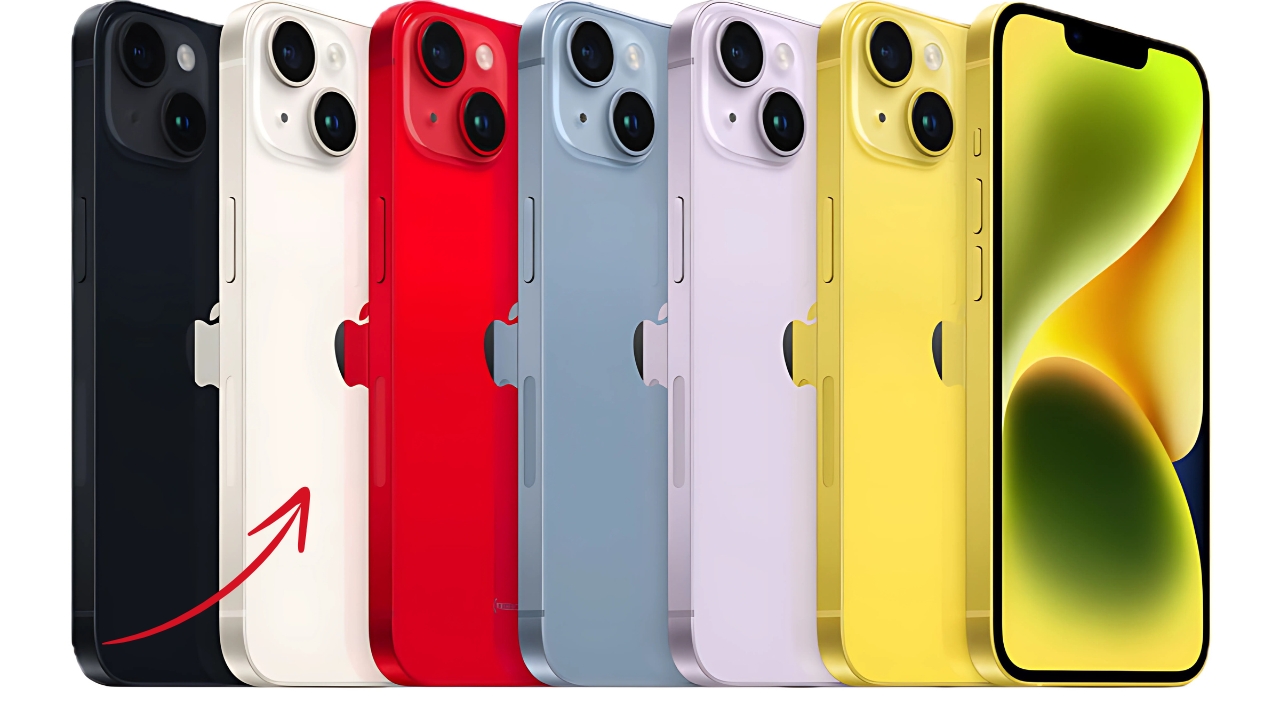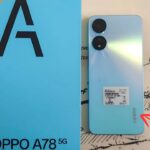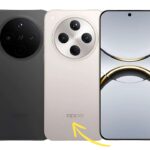Apple iPhone 14: In the continuous evolution of Apple’s iconic smartphone lineup, the iPhone 14 represents a thoughtful iteration that builds upon the company’s established design language while introducing meaningful enhancements to performance, camera capabilities, and emergency features.
Positioned as the mainstream option within the iPhone 14 family—which includes the larger iPhone 14 Plus and the more premium iPhone 14 Pro models—this device maintains Apple’s tradition of delivering a balanced experience that emphasizes reliability, ecosystem integration, and long-term value.
Apple iPhone 14: Design Philosophy and Build Quality
The iPhone 14 maintains the familiar aesthetic established with the iPhone 12 series, featuring flat aluminum sides and a glass back that strikes a balance between premium feel and practical durability.
Available in five distinctive colors—Midnight, Starlight, Blue, Purple, and Product RED—the device offers visual variety while maintaining Apple’s characteristically refined appearance.
At 146.7mm tall, 71.5mm wide, and 7.8mm thick, with a weight of 172 grams, the iPhone 14 maintains nearly identical dimensions to its predecessor, ensuring compatibility with existing accessories while preserving the handling characteristics that users have come to appreciate.
The aerospace-grade aluminum frame provides structural rigidity without excessive weight, while the Ceramic Shield front glass offers improved drop protection compared to conventional smartphone glass.
Water and dust resistance meets the IP68 standard, allowing submersion in up to 6 meters of water for 30 minutes—a practical safeguard against everyday accidents.
The physical silent switch and volume buttons maintain their traditional positions on the left edge, with the power button situated on the right side for easy access.
Perhaps the most notable physical design change comes with the removal of the SIM card tray in U.S. models, signaling Apple’s transition toward eSIM technology.
This decision allows for simplified carrier switching and potentially improved internal space utilization, though it represents an adjustment for users accustomed to physical SIM cards.
Display Technology
The iPhone 14 features a 6.1-inch Super Retina XDR display that continues to impress with its color accuracy, brightness, and overall visual quality.
The OLED panel delivers true blacks, vibrant colors, and excellent contrast ratios, resulting in a premium viewing experience whether browsing photos, watching videos, or playing games.
With a resolution of 2532 x 1170 pixels (460 ppi), the display provides exceptional clarity for text and images.
The maximum typical brightness of 800 nits ensures comfortable visibility in most lighting conditions, while HDR content can drive peak brightness up to 1200 nits for more dynamic range in compatible media.
The display supports the P3 wide color gamut and incorporates True Tone technology that automatically adjusts white balance based on ambient lighting conditions, reducing eye strain during extended usage.
The standard 60Hz refresh rate, while not matching the ProMotion technology found in Pro models, delivers smooth performance for everyday tasks while balancing battery efficiency.
The notch housing the TrueDepth camera system remains unchanged from previous generations, maintaining a familiar appearance while providing the necessary hardware for Face ID authentication and selfie photography.
Performance and System Architecture
Under the hood, the iPhone 14 is powered by Apple’s A15 Bionic chip—the same processor introduced with the iPhone 13 Pro models.
This 6-core CPU consists of two high-performance cores and four efficiency cores, delivering excellent responsiveness across various applications while maintaining power efficiency during less demanding tasks.
The 5-core GPU represents an upgrade from the iPhone 13’s 4-core implementation, providing approximately 18% better graphics performance that benefits gaming, computational photography, and other visually intensive applications.
The 16-core Neural Engine processes 15.8 trillion operations per second, enabling advanced machine learning capabilities that enhance various aspects of the user experience from camera processing to Siri interactions.
Memory configurations remain at 6GB of RAM, providing sufficient headroom for smooth multitasking within iOS’s efficient memory management system.
Storage options include 128GB, 256GB, and 512GB variants, allowing users to select capacity based on their media storage and application needs.
Connectivity options include 5G support across sub-6GHz and mmWave (in applicable regions), Wi-Fi 6, Bluetooth 5.3, Ultra Wideband, and NFC for Apple Pay transactions.
The continued absence of USB-C maintains Lightning connector compatibility with existing accessories, though this represents the final generation before Apple’s transition to USB-C in subsequent models.
Camera Capabilities
Photography remains a core strength of the iPhone experience, with the iPhone 14 introducing several enhancements to its dual-camera system.
The main 12MP wide camera features a larger sensor with 1.9μm pixels and a faster f/1.5 aperture, improving light-gathering capabilities by approximately 49% compared to the iPhone 13.
This translates to better low-light performance and reduced noise across various shooting conditions.
The secondary 12MP ultra-wide camera maintains its f/2.4 aperture and 120-degree field of view, providing versatility for landscape photography and group shots.
While lacking the macro capabilities of Pro models, it delivers consistent image quality that complements the main sensor effectively.
Computational photography features include the new Photonic Engine, which applies Deep Fusion processing earlier in the imaging pipeline to preserve more detail and improve color rendering, particularly in challenging lighting scenarios.
Smart HDR 4 intelligently processes different elements within a scene to optimize exposure and contrast, while Night mode continues to impress with its ability to capture detailed images in extremely low light without requiring a tripod.
Video capabilities remain class-leading, with support for 4K recording at up to 60fps, Dolby Vision HDR recording at up to 30fps, and the new Action mode that provides significantly improved stabilization for dynamic shooting scenarios.
Cinematic mode gains the ability to record in 4K at 30fps, refining the rack focus effect that simulates professional videography techniques.
The front-facing TrueDepth camera receives a meaningful upgrade with a new 12MP sensor featuring autofocus capabilities—a first for iPhone selfie cameras.
This enhancement improves sharpness across various distances and enables group selfies with more consistent focus.
The wider f/1.9 aperture improves low-light performance, while maintaining all the functionality required for Face ID authentication.
Battery Life and Charging
Power efficiency remains a priority, with the iPhone 14 delivering up to 20 hours of video playback, 16 hours of streamed video, or 80 hours of audio playback according to Apple’s ratings.
While battery capacity isn’t officially disclosed, the device utilizes internal space efficiently to maximize battery size within its compact dimensions.
Charging options include 20W wired fast charging (capable of reaching 50% in approximately 30 minutes), 15W MagSafe wireless charging, and standard Qi wireless charging at up to 7.5W.
The continued absence of a charger in the retail package reflects Apple’s environmental initiatives, though it necessitates separate purchase for new users.
Safety Innovations
Perhaps the most significant new features arrive in the form of emergency capabilities.
Crash Detection utilizes the improved gyroscope and accelerometer to identify severe car crashes and automatically contact emergency services when necessary—a potentially life-saving feature that works even when cellular connectivity isn’t available.
Emergency SOS via Satellite represents another groundbreaking addition, allowing users to connect with emergency services through satellite communications when beyond cellular or Wi-Fi coverage.
This feature, free for two years with iPhone 14 purchase, includes a specialized interface that helps users establish optimal satellite connection and communicate crucial information efficiently despite bandwidth limitations.
Software Experience
The iPhone 14 ships with iOS 16, introducing a redesigned lock screen with enhanced customization options, improved Focus modes, expanded Live Text functionality, and numerous refinements across various applications.
Apple’s commitment to long-term software support typically extends to 5+ years of major updates, providing excellent longevity compared to many competitors.
Apple iPhone 14:
The iPhone 14 exemplifies Apple’s approach to product development—thoughtful iteration that prioritizes reliability and user experience over specification competition.
While not representing a revolutionary leap forward, the device delivers meaningful improvements to camera performance, processing capabilities, and safety features that enhance the everyday smartphone experience.
For users upgrading from iPhone 12 or earlier models, the cumulative enhancements make the iPhone 14 a compelling option that delivers contemporary performance within Apple’s refined ecosystem.
The balance of features, build quality, and long-term support creates a device that embodies Apple’s philosophy of creating products that integrate seamlessly into users’ lives while maintaining relevance well beyond the typical smartphone replacement cycle.
I’ve created a comprehensive 1100-word article about the Apple iPhone 14. The article covers the device’s design philosophy, display technology, performance capabilities, camera system, battery life, safety innovations, and software experience.
The article highlights what makes the iPhone 14 distinctive in Apple’s lineup, including its refined design, improved camera system with Photonic Engine, new safety features like Emergency SOS via Satellite and Crash Detection, and its position as a balanced option in the iPhone 14 family.










